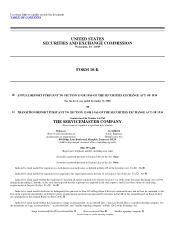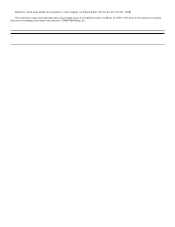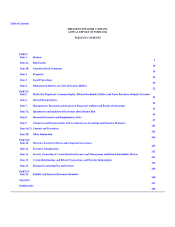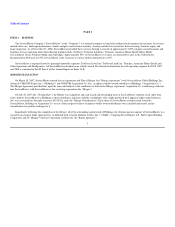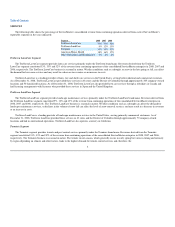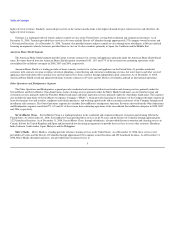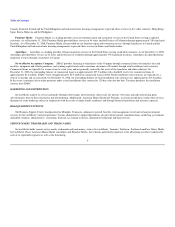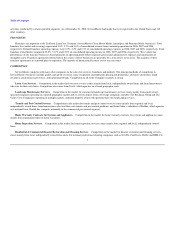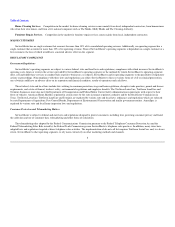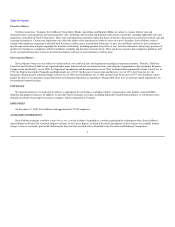American Home Shield 2008 Annual Report Download - page 12
Download and view the complete annual report
Please find page 12 of the 2008 American Home Shield annual report below. You can navigate through the pages in the report by either clicking on the pages listed below, or by using the keyword search tool below to find specific information within the annual report.
Table of Contents
ITEM 1A. RISK FACTORS
The following discussion of risk factors contains "forward-looking statements," as discussed in Item 7. These risk factors may be important to
understanding any statement in this Annual Report on Form 10-K or elsewhere. Our business, operations and financial condition are subject to various risks.
The risks and uncertainties described below are not the only ones relevant to us. Additional risks and uncertainties not currently known to us or that we
currently believe are immaterial may also impair our business, results of operations, financial condition and liquidity. The following information should be
read in conjunction with Management's Discussion and Analysis of Financial Condition and Results of Operations and the consolidated financial statements
and related notes included elsewhere in this Annual Report on Form 10-K.
Risks Related to Our Business and Our Industry
Recent market events and conditions, including disruptions in the U.S. and international credit markets and other financial systems and the
deterioration of U.S. and global economic conditions, could, among other things, impede access to or increase the cost of financing, cause our lenders
to depart from prior credit industry practice and not give technical or other waivers under our Credit Facilities (as defined below) to the extent we
may seek them in the future, thereby causing us to be in default under one or more of the Credit Facilities, cause our commercial customers to incur
liquidity issues that could lead to some of our services being cancelled and/or result in reduced revenues and lower operating income and cash flows,
which would have an adverse effect on our financial condition or results of operations.
In the second half of 2007, the U.S. residential mortgage market began to experience serious disruption due to credit quality deterioration and
delinquencies in a significant portion of originated mortgages, particularly subprime and non-prime mortgages; foreclosure activity began to rise; the
residential housing market began to experience a slowing pace of transactions, declining housing prices and increased cost and reduced availability of
mortgages; delinquencies in non-mortgage consumer credit increased; consumer confidence began to decline and credit markets became disrupted and
illiquid. These conditions continued and worsened throughout 2007 and 2008 and into 2009, expanding into a crisis of confidence in the broader U.S. and
global credit and financial markets and resulting in greater volatility, less liquidity, widening of credit spreads, a lack of price transparency, increased credit
losses and tighter credit conditions. Securities and debt ratings have been downgraded and a number of institutions have defaulted on their debt, filed for
bankruptcy or have been taken over. Concerns about various financial instruments, banks, investment banks, insurers and other financial institutions caused
the broader credit markets to deteriorate further, notwithstanding various actions by the U.S. and foreign governments. In addition, the unemployment rate has
been increasing and the economy has been contracting. Concerns about adverse developments in the credit and financial markets, declining consumer
sentiment, increased unemployment, economic contraction and uncertainty about corporate earnings continue to challenge the U.S. and global financial and
credit markets and overall economies.
These unprecedented disruptions in the current credit and financial markets have had a significant material adverse impact on a number of financial
institutions and have limited access to capital and credit for many companies. These disruptions could, among other things, lead to impairment charges, make
it more difficult for us to obtain, or increase our cost of obtaining, financing for our operations or investments or to refinance our debt in the future, cause our
lenders to depart from prior credit industry practice and not give technical or other waivers under our $2,650 million senior secured term loan facility (the
"Term Loan Facility") and $150 million pre-funded letter of credit facility (together with the Term Loan Facility, the "Term Facilities") or our $500 million
senior secured revolving credit facility (the "Revolving Credit Facility") (the Term Facilities and Revolving Credit Facility are collectively referred to herein
as the "Credit Facilities") to the extent we may seek them in the future, thereby causing us to be in default under one or more
10


